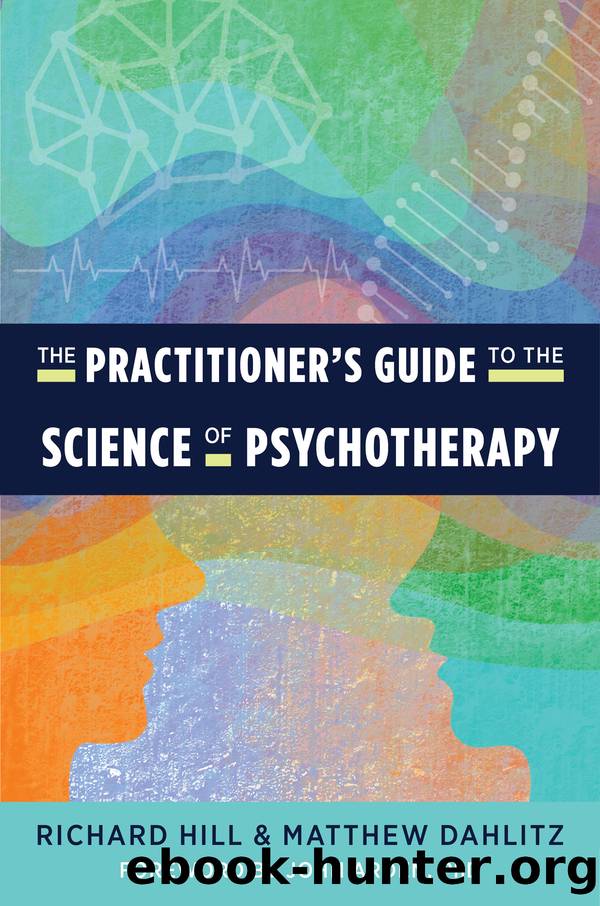The Practitioner's Guide to the Science of Psychotherapy by Richard Hill

Author:Richard Hill
Language: eng
Format: epub
Publisher: W. W. Norton & Company
Published: 2022-02-03T00:00:00+00:00
Some clues as to the etiology of impulse control disorder come from the study of patients with Parkinsonâs disease who commence dopamine replacement therapy. About 15% of them develop such impulsivity and many more subclinical symptoms (Vriend, 2018). Similar manifestation of ICD is seen in patients who do not have Parkinsonâs but are being treated with dopaminergic drugs. In one such study, patients being treated for restless legs syndrome developed pathological gambling (Tippmann-Peikert et al., 2007).
So, what exactly is going on here? First, endogenous dopamine release in the ventral striatum, relating to reward, pauses when a negative outcome follows a behaviorâsignaling to the individual to avoid doing that again. Introducing dopamine D2 receptor agonists increases impulsivity by preventing these natural pauses when there is a negative outcome (van Eimeren et al., 2009). Thus, the person does not get the encoding needed to avoid the negative behavior in the future, while leaving dopamine D1 receptors to maintain any positive reinforcement intact. For ICD it is reasonable to speculate that something is going on in the reward-related pathways of the cortico-striatal-thalamo-cortical circuit, the brain circuit that controls movement execution, reward, and habits, to cause impulsivity.
Parkinsonâs disease also progresses to destroy serotonin- and norepinephrine-producing neurons, which can contribute to impulsivity. Increasing serotonin in the synaptic cleft through SSRIs has been shown to reduce impulsivity in OCD, although the effect is extremely varied with Parkinsonâs patients (Vriend, 2018, pp. 329â330). Similarly, increasing noradrenergic signaling can improve impulse control (Baarendse et al., 2013), yet the complex interactions between serotonin, dopamine, and norepinephrine make it difficult to get a clear causal picture of ICD. Does the cortico-striatal-thalamo-cortical circuitry contain genetic factors that predispose individuals to ICD, or to the development of ICD in difficult environmental/relational circumstances? The jury is still out.
Besides the research on Parkinsonâs disease, there are studies focused on executive function and impulsivity in borderline personality disorder (BPD) and ADHD, where the lack of impulse control is a marked feature. A systematic review by Sebastian et al. (2014) lay out the multiple components of impulsivity and the many variables that depend on the individual, disorder, environment, circumstances, and so on. As we continually emphasize, it is complex! What seems to be clear is that impulse control in BPD and ADHD revolves around the ventrolateral, ventromedial, and dorsal aspects of the prefrontal cortex (PFC), as well as the inferior frontal gyrus, insula, and ACC. In BPD, dealing with emotional stimuli may be accompanied by hypoactivation in the dorsal ACC and the dlPFC (Holtmann et al., 2013; Wingenfeld et al., 2009) that is also associated with negative emotionality in BPD (Ruocco et al., 2013). Hypoactivation of the orbital and medial PFC is also evident in BPD behavioral inhibition studies (G. A. Jacob et al., 2013; Silbersweig et al., 2007). It is not known, however, whether this hypoactivation is due to disturbed emotional processing in BPD (refer to Section 4.6) or to underlying impulse control deficits.
Similar hypoactivation of these executive functioning areas of the brain have been found in ADHD.
Download
This site does not store any files on its server. We only index and link to content provided by other sites. Please contact the content providers to delete copyright contents if any and email us, we'll remove relevant links or contents immediately.
The Art of Thinking Clearly by Rolf Dobelli(8869)
The 5 Love Languages: The Secret to Love That Lasts by Gary Chapman(8530)
Mindhunter: Inside the FBI's Elite Serial Crime Unit by John E. Douglas & Mark Olshaker(7850)
Becoming Supernatural by Dr. Joe Dispenza(7121)
The Road Less Traveled by M. Scott Peck(6650)
Nudge - Improving Decisions about Health, Wealth, and Happiness by Thaler Sunstein(6644)
Enlightenment Now: The Case for Reason, Science, Humanism, and Progress by Steven Pinker(6415)
Win Bigly by Scott Adams(6328)
Mastermind: How to Think Like Sherlock Holmes by Maria Konnikova(6253)
The Way of Zen by Alan W. Watts(5813)
Factfulness: Ten Reasons We're Wrong About the World – and Why Things Are Better Than You Think by Hans Rosling(4032)
The State of Affairs by Esther Perel(3946)
Gerald's Game by Stephen King(3928)
Man's Search for Meaning by Viktor Frankl(3649)
The Confidence Code by Katty Kay(3576)
Thinking in Bets by Annie Duke(3542)
The Worm at the Core by Sheldon Solomon(2928)
Enlightenment Now by Steven Pinker(2920)
Liar's Poker by Michael Lewis(2821)
